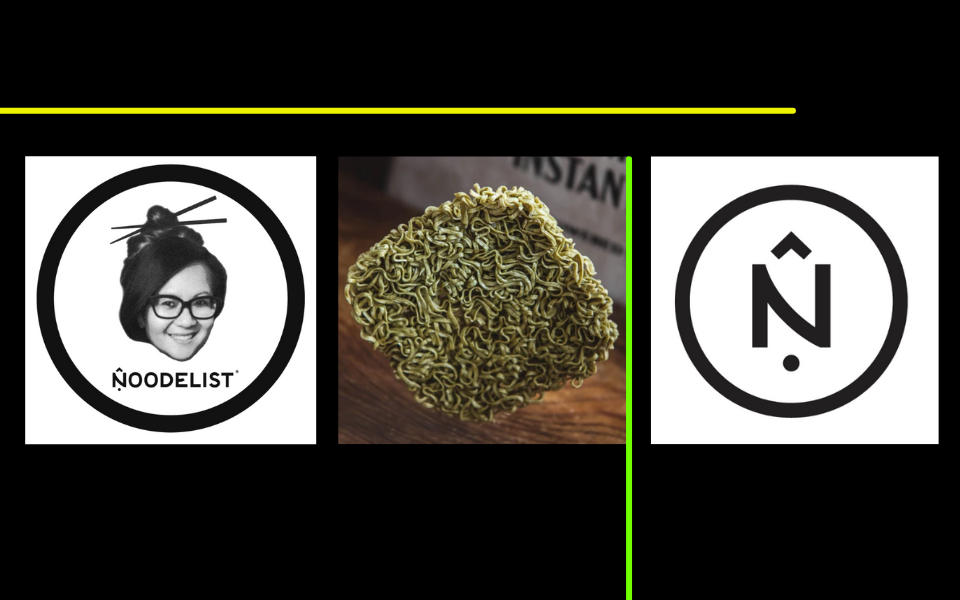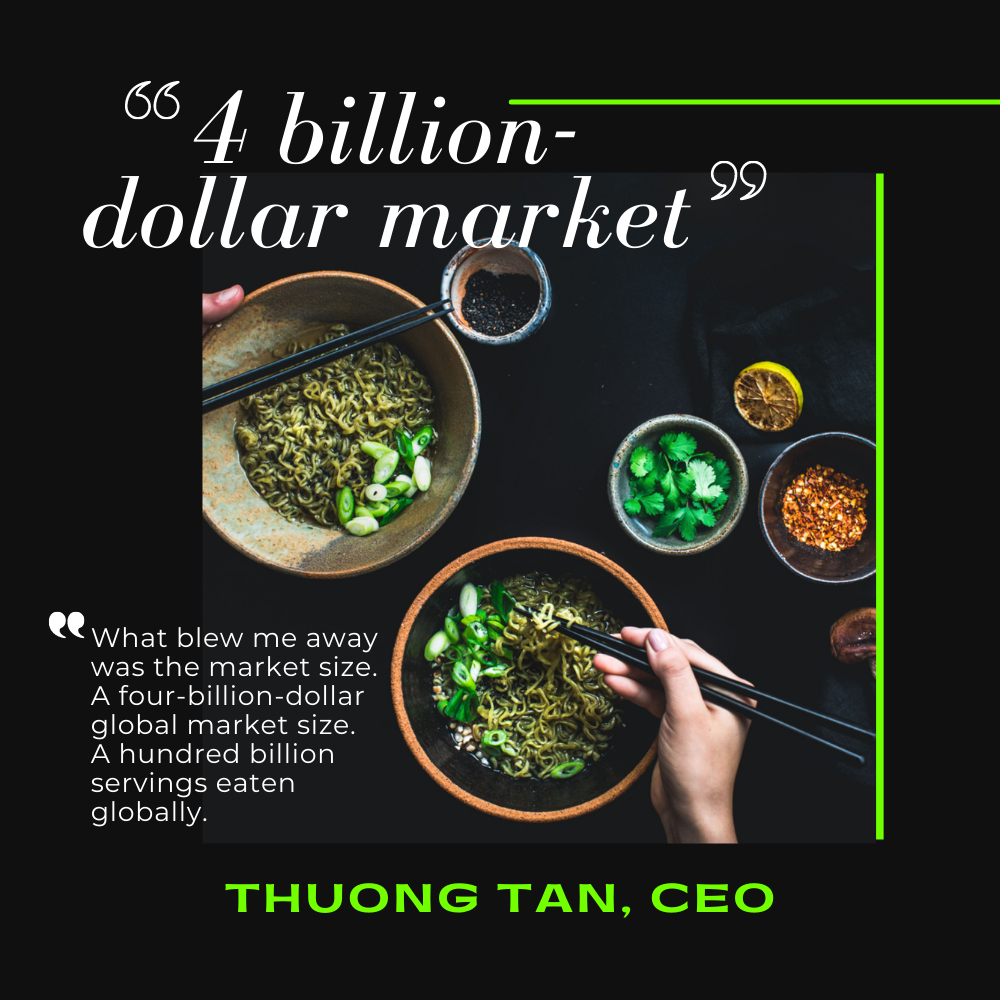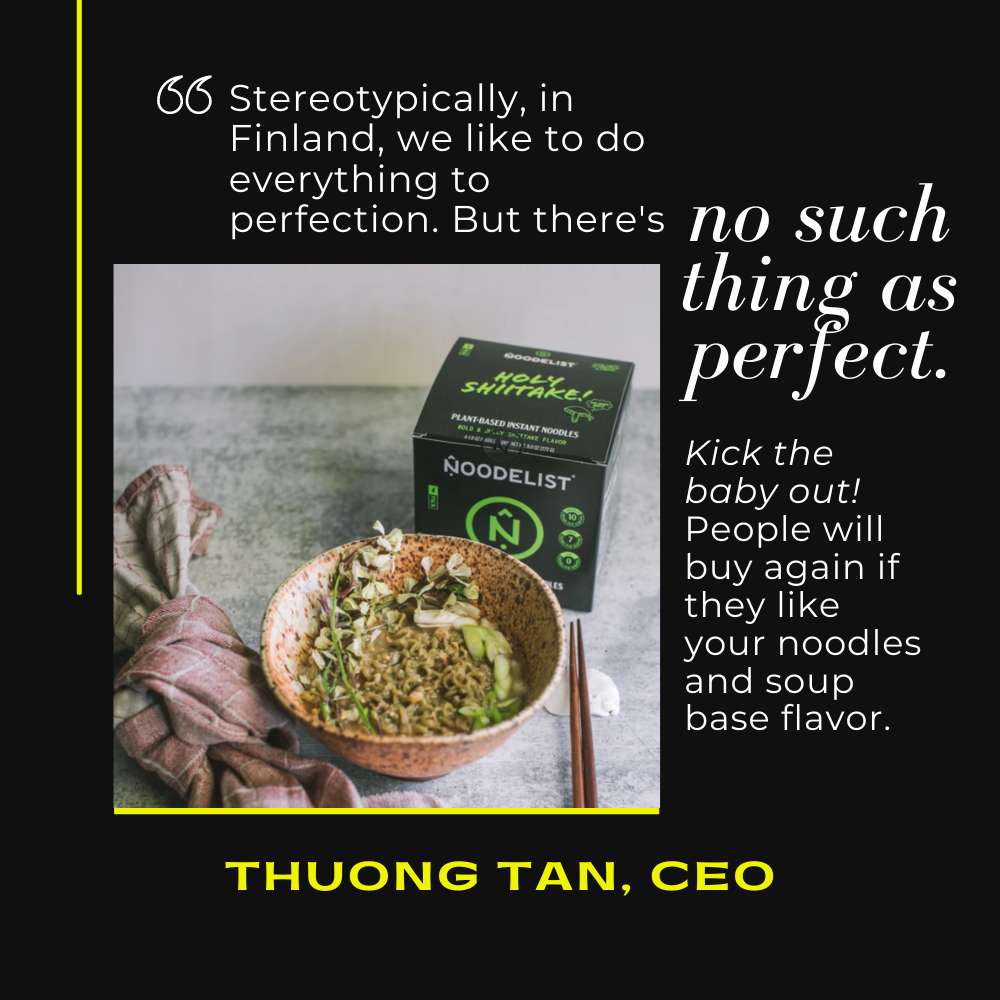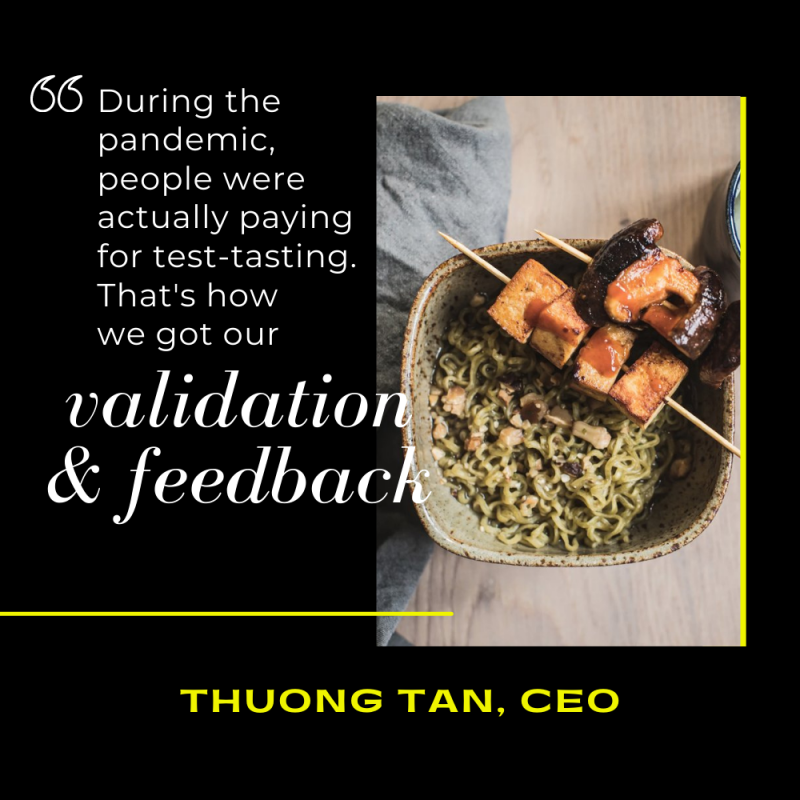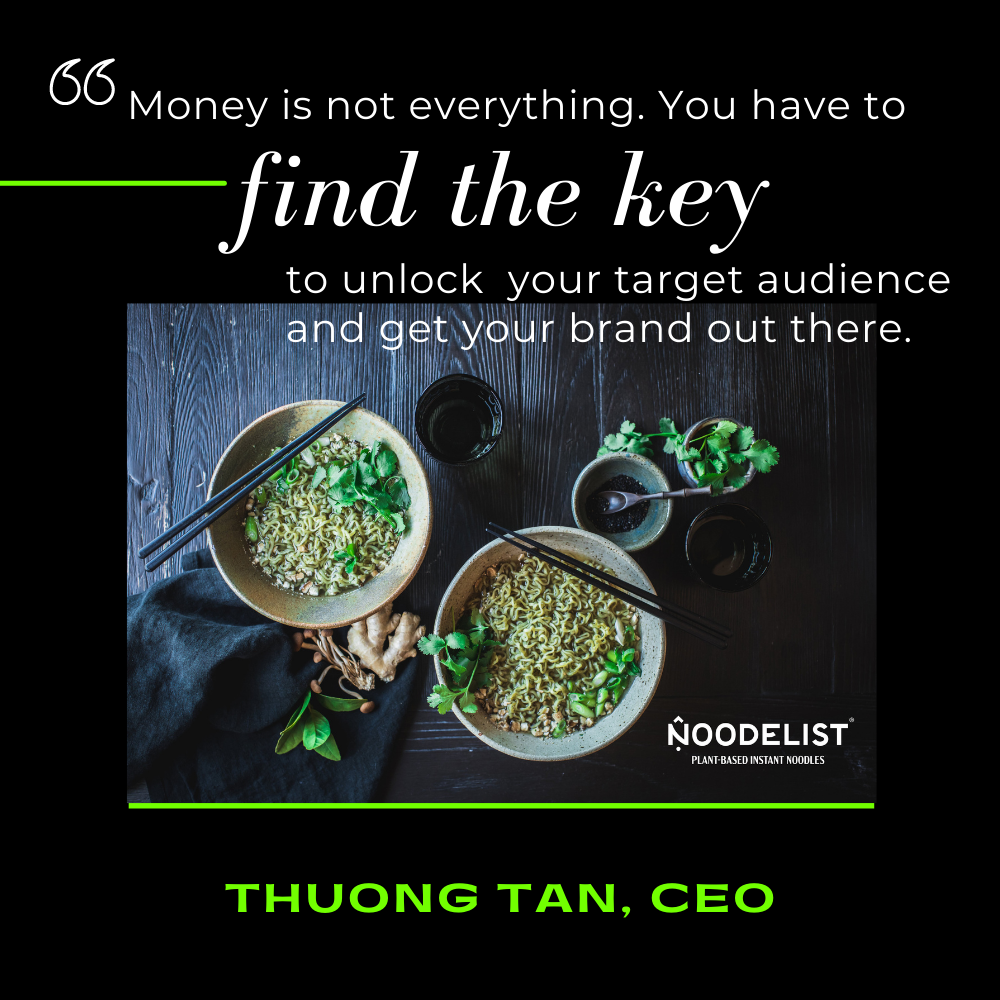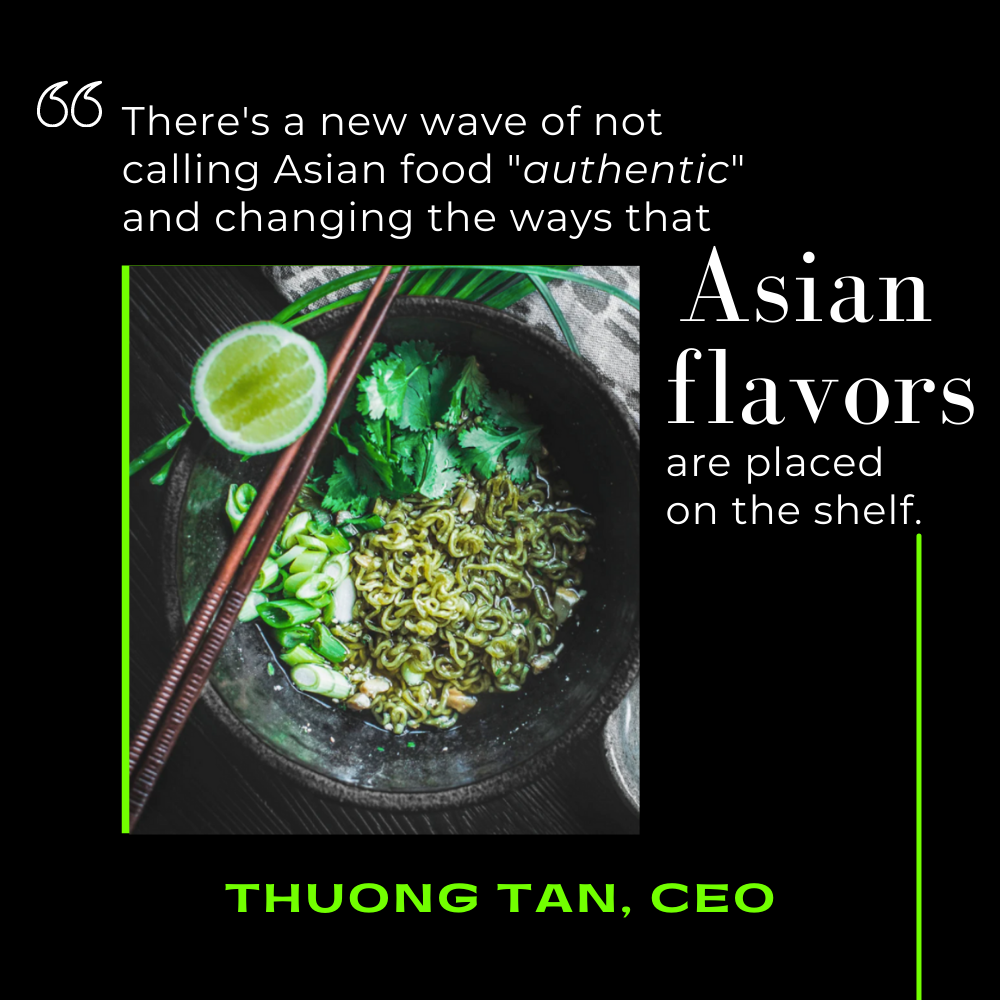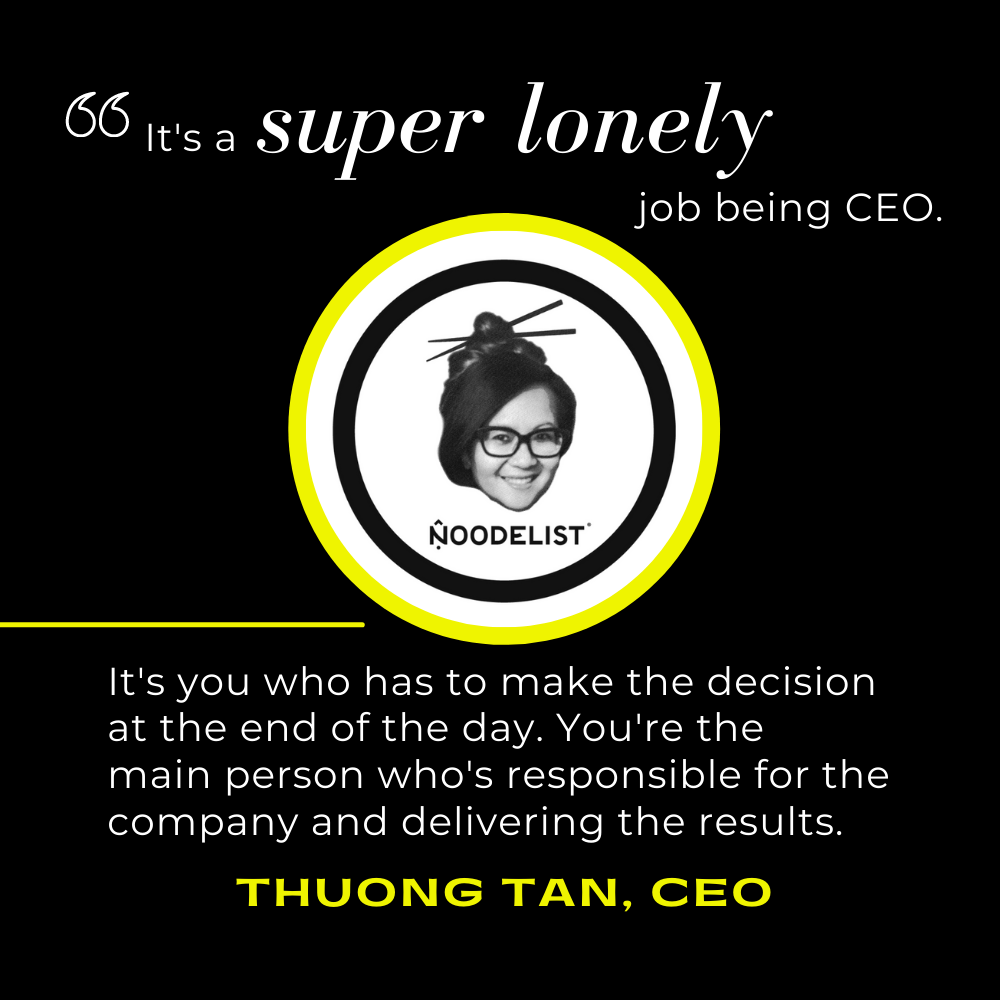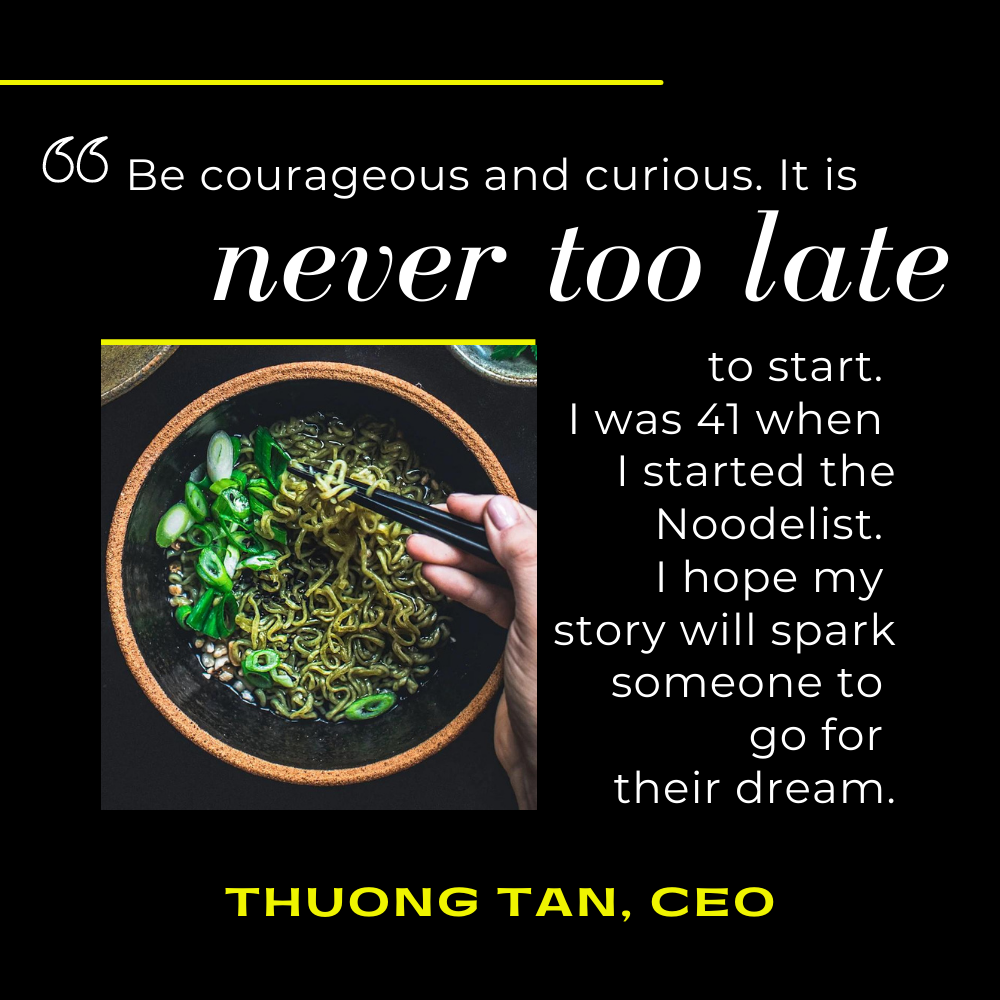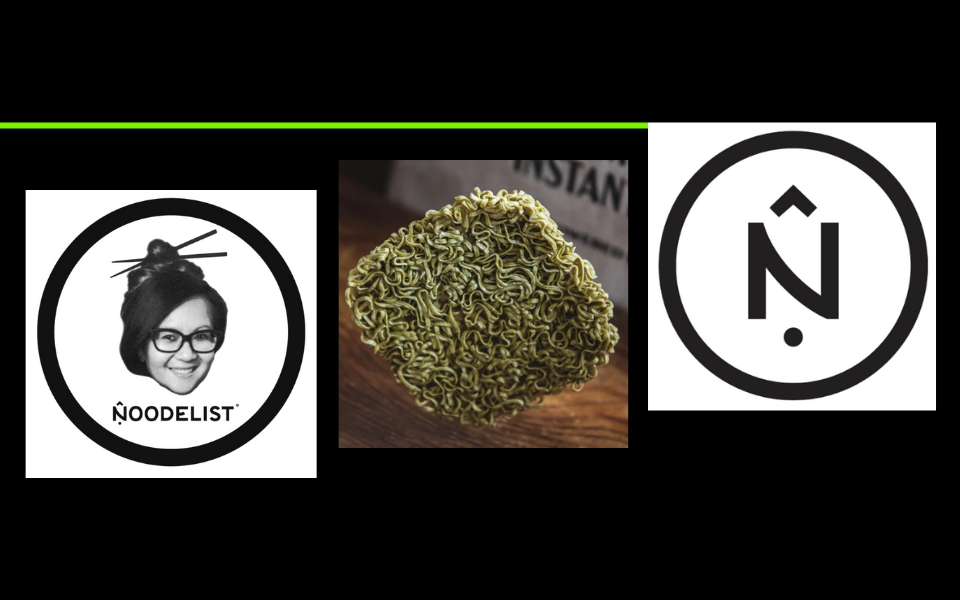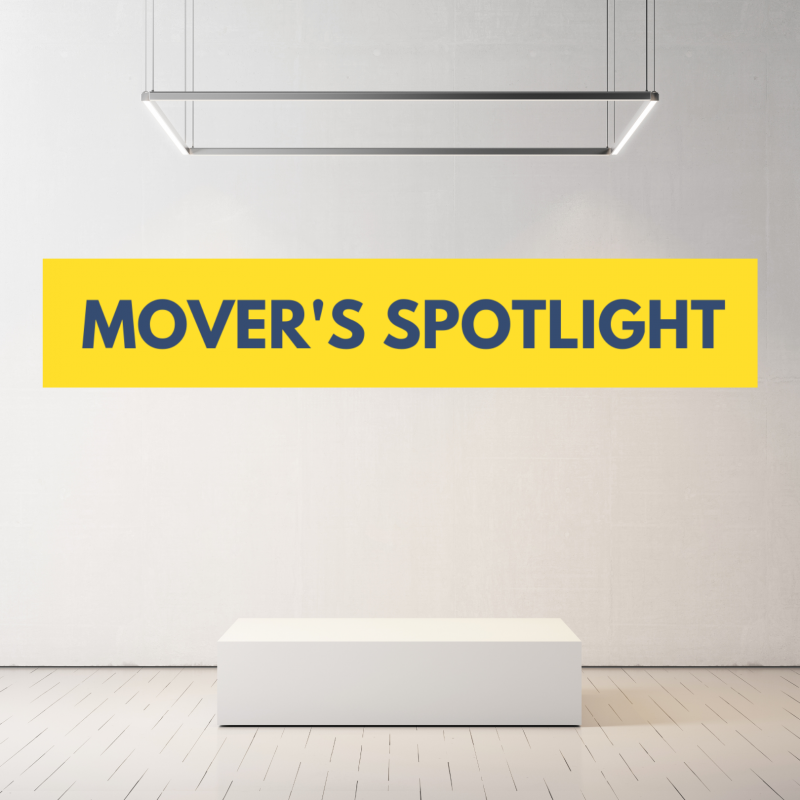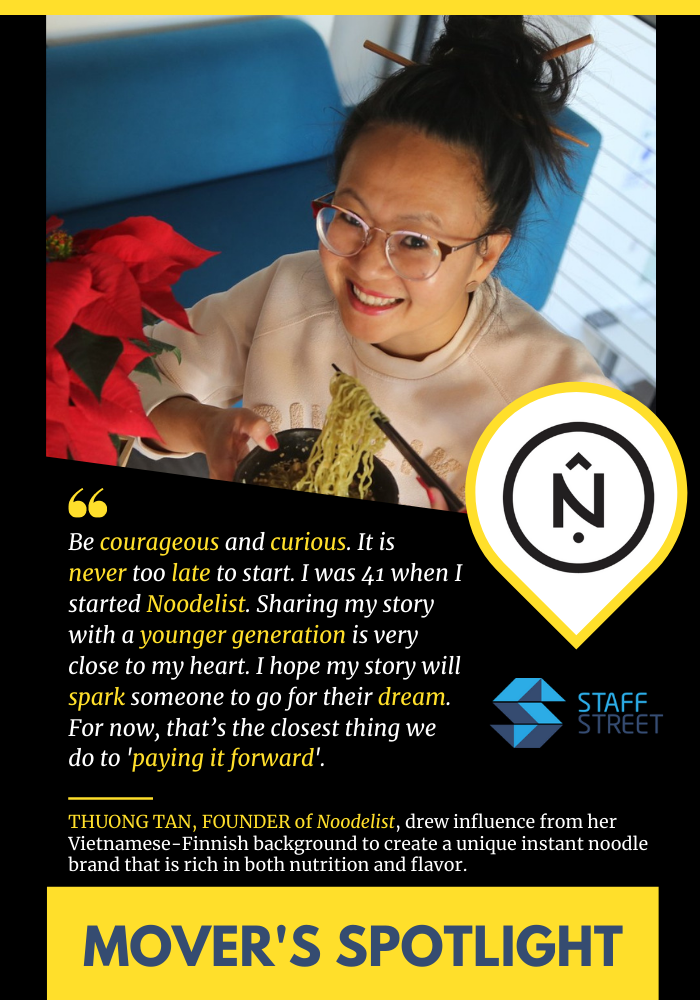
Tell us a little bit about your journey. I know that you lived in several countries and your relationship with the staple food in these countries led you to creating the Noodelist noodles. In your own words, how did you come to starting your own noodle brand?
Thuong Tan: That’s the Noodelist tagline, right? I’m half-Vietnamese and half-Chinese, born in Saigon. But I don’t eat rice. I grew up in Finland after my family moved there when I was four. The staple food there are potatoes. I don’t care about potatoes either. Then, I ended up in Silicon Valley. It was supposed to be a six-month internship in 2003. And if it’s Silicon Valley or L.A. or California, you go for tacos and burritos. But not me. I wanted my noodles. I’m literally a noodle junkie. I could eat noodles five times a day all the time.
In 2014, I did my MBA in luxury brand management. It was for a simple marketing class where we had to come up with the Seven P’s of a daily product that we use. Of course, I thought of instant noodles. What blew me away was the market size. A four-billion-dollar global market size. A hundred billion servings eaten globally. They’re all from the same Asian brands that I love.
But after I came back and kept pitching my instant noodle 2.0, a lot of my friends were conscious about all the amounts of sodium. It’s basically all carbs and zero nutrition. So, they were like, “Make it better. Healthier. But still, keep the taste, and I will eat it.” So, it came to me: plant-based noodles.
Making instant noodles better-for-you.
Thuong Tan: Initially, I wasn’t going to do the plants because I thought we would sacrifice the taste. But I learned that I was so wrong. The plant-based is not just a passing trend. It’s going to be the new normal. So, I’m glad that I listened to my food scientist and we stuck with the plant-based. Since we had an award-winning Chef to create the recipe, we leaned on taste first.
For me, the important part was to boost the nutrition. So, I ate through all the competitors. Hundreds of them. Put them on an excel sheet just to compare the nutrition facts. In order for us to differentiate the Noodelist, we needed to boost up the protein. Ten grams of protein, seven grams of fiber, less fat, less sodium, boom! We had our instant noodle 2.0.
Since ideas are cheap, big brands could copy us anytime. So, my branding mentor told me, anything can be copied except your original branding story. Right? They can’t combine the Asian slash Nordic slash Silicon Valley origins, which we put into our branding story, because it’s real.
You mentioned earlier the plant that you use as your base. It’s called Moroheiya. How did you come across this plant?
Thuong Tan: I started Noodelist by first finding the right noodles. I know that we’re not going to re-invent the bike with a bunch of noodle manufacturers and makers, right? This year, a lot of competitors emerged in the same category—which is good. It means that this is the right timing for a better-for-you instant noodle brand.
So, I started with the noodles. I knew that there were healthy ingredients in varieties, made with chickpea and buckwheat. But when you’re talking about instant, that means that you’re making your instant noodle by just boiling the water, and waiting for three to five minutes. When you use healthy ingredients with that, the noodle texture will remain al dente or they become too soggy.
While I was in LA, I found our noodles at the local organic store. They were almost too green. But I needed to try everything. I found their sole distributor here in the Bay Area. Which is another lucky factor. I asked them whether we could collaborate and partner up.
The texture was number one. The noodles had a good texture and it happened to have moroheiya, which nobody had heard about. Kale was the most popular health thing and Moringa is getting mainstream. But Moroheiya is the king of vegetables, also known as Egyptian spinach.
All the stars lined up. The Noodelist noodles have great texture and include a cool-sounding ingredient, moroheiya that nobody has heard of, yet. And we just wrote a blog about it. Moroheiya is loaded with a flavonoid called quercetin which has really promising health benefits and, in some studies, has been found to improve exercise performance.
You have a massive market for instant noodles and your noodles are based on a relatively new ingredient. What was it like when you rolled out your first iteration? How did people react to the noodles?
Thuong Tan: We did a lot of blind tasting with the first Noodelist flavors. You start with family and friends, right? You force them to do testing. Then, last year, the pandemic happened. We had the white label noodles, our own soup base, but no packaging. Nothing. Then, people started working from home, Silicon Valley-style, and deliveries became the norm.
There were parts that weren’t ready, but the edible product was ready. So, we were so lucky because everybody wanted deliveries. So, I packed up everything in my Mini Cooper, started selling and delivering, and gathered feedback from there.
Stereotypically, in Finland, we like to do everything to perfection. But there’s no such thing as “perfect”. At the time, I was trying to perfect the packaging. I was trying to imitate what I learned from luxury branding. I was making food. My investor told me, “Kick the baby out! People will buy again if they like your noodles and soup base flavor. They don’t care about the packaging—they don’t eat the packaging.”
And thanks to the pandemic, people were actually paying for test-tasting. And we were able to improve and validate the pricing and packaging. That’s how we got our validation and feedback for the first two flavors. And people are now constantly asking, “What will be your third flavor?” It’s nice to be asked, but it takes another level to execute and deliver. We just got our packaging literally this year after doing a minimum viable version.
And your packaging doesn’t just look cool. I read on your website that it’s pretty compostable, right? It’s environmentally friendly.
Thuong Tan: Yeah, although I actually wanted the Noodelist box to be biodegradable. But they only had the machinery for the biodegradable coffee cup version. And the other thing is, the biodegradable material lasts about six months. And our product is 12-month shelf-stable.
We also make our boxes striking. We communicate fun ideas on the side. Our sample box is called the Double Trouble. It’s a sample pack of two-for-two servings put per flavor. And once they like it and they find their favorite, they can go for either Lemongrass Vegan Chicken’ish or Bold and Juicy Shiitake. They can also go out for the Survival Box, which is bigger and you get a better deal.
I saw the Survival Box. How many noodles do you have in it?
Thuong Tan: The Noodelist Survival Box has 24 meals, with 12 of each flavor. Or you can also buy just a box full of one flavor. The idea for it was thanks to the pandemic. I just wanted to keep it super simple. Put everything in the bigger box and get them delivered. I realized that people were ordering again, restocking the Survival Box every month.
Thanks for bringing up last year. Is there anything that you learned from the pandemic that has shaped your strategy moving forward when it comes to whether your branding or marketing?
Thuong Tan: Sales channels—my original pitch was that because I’m in Silicon Valley, the Noodelist will work with tech companies. When you go to these tech offices, you see that the employers are providing free treats, snacks, power bars, soft drinks, and all that. I was like, “Hey. That’s a great channel to reach the target audience.”
But then, last year, everybody was staying at home. All right! New channels up! So there’s direct-to-consumer. But then you really need to learn the trick of digital marketing and where to put your ads. Money is not everything. You really need to find THE way to reach your target audience, young techie millennials, and busy working parents.
We also received validation from parents who have one kid in a college and then family at home to feed. They were basically buying two Survival Boxes per month once. So, just finding new channels and focusing on the e-commerce marketplace. Like GoodEggs or The Faire that would reach out to the other small stores around the U.S. You have to find the key to unlock the target audience and get your brand out there.
The most positively surprising part was Yelp. You think it’s just for restaurants, right? We did a virtual noodle-cooking online event with Yelp Elites. And after that, my friend helped me create a Yelp page. We’ve been putting money in Facebook and Google ads. It wasn’t making any dent. So, we tried Yelp, which has created a super positive increase in our website and sales. And this month, because of the Asian American Pacific Islander Heritage Month, they’ve been boosting Asian and female-owned businesses.
I’m so glad that you mentioned Asia American Pacific Islander Heritage Month. Last month, we spoke with Nona Lim. She talked about the changing trends when it comes to Asian food and the general consumer expanding their experience with Asian food. I was wondering if you thought the same thing.
Thuong Tan: Oh, she’s a food goddess! Oh yes, I’ve been following Omsom. They’re this super cool brand by fellow Vietnamese sisters on the East Coast. We launched around the same time. They’re doing a totally new level of marketing. They’re creating a new wave of not calling Asian food “authentic” and changing the ways that Asian flavors are placed on the shelf. And they’re also changing the stigma around MSG as well. Because there’s no scientific proof about it being bad for you.
So, there’s definitely a new wave trend. When you look at the population in the U.S., it’s a melting pot. Especially the Bay Area, where it’s 30% Asian. So, there’s definitely a lot of Asian Heritage influence. For me, if I get stranded on an island, I would want to be stranded with an Asian Chef. Hands down. I think we’re so spoiled here on the West Coast because we can go out for any kind of cuisine. I’ve definitely seen a spike in terms of flavors and homemade types of dishes you usually find in restaurants.
And another thing that I wanted to ask you was that you mentioned new channels and basically new ways of marketing and new ways of getting it out there. Do you, as a brand, work with influencers?
Thuong Tan: I wish we had the budget. Okay, we have that budget as we go. You really need to be super creative when you don’t have a budget, too. I do have a lot of connections from LinkedIn. But it really does take a huge budget to use celebrity influence. We’re currently in a trial mode to see what works and what doesn’t because we just don’t have the thousands and hundreds to put into different channels to see what works. I scroll through different influencers and try to find micro-influencers to grow organically.
Here’s a more personal question. Having gone through the journey to Noodelist, what is your biggest strength as the CEO and the brand manager?
Thuong Tan: I started Noodelist as the sole founder. It was really hard to find a co-founder, it’s like finding a husband or wife or partner. I was lucky to get a COO on board last October. I’ve learned what I’m good at and what I’m not. I really enjoyed the selling part, the marketing, and any role on the front end. So, that’s why I had to find a COO to log the numbers and handle the back end of the fulfillment. I call her, Jenni Backholm, my wife (laugh).
It’s a super lonely job being a CEO. You are in the middle: you report to investors at one point and then you talk to the team. But it’s still you by yourself as a CEO who has to make the decision at the end of the day.
I’m super lucky. I have what I would call a village of advisors, mentors, family, friends, and fellow founders that I could bounce ideas. But still. It’s a challenging job to wear all the hats because you’re the main person who’s responsible for the company and deliver the results.
What’s a lesson or a key takeaway from your experience that you would pay forward as a piece of advice to other up-and-coming CPG brands in the same category?
Thuong Tan: When you can’t speak to big sponsors money-wise, we do it at an organic level. During the pandemic, we were giving out free noodles to frontline workers, hospital doctors, and nurses. With the Finnish community that I’m part of, we do events where we make sales and we give all the profits to the foundation that gives to young Finnish artists and academics. I also ask a lot of questions from other experienced CPG founders so I can learn from them.
This month, Noodelist is sponsoring by giving noodles to all these events that give more attention to Asian American Pacific Islanders Heritage Month. And I’m never too busy to share my time and what I’ve learned with young students. I love to share the stories and share the experience and encourage them to nurture their ideas and jump into the challenge. Be courageous and curious. And that it’s never too late to start. I was 41 when I started Noodelist. Sharing my entrepreneurial story with a younger generation is very close to my heart. I hope my story will spark someone to go for their dream. For now, that’s the closest thing we do to “paying it forward”—before we make millions, so we can make real sponsorships.
What exciting projects are you looking forward to this year?
Thuong Tan: Getting the Noodelist brand and our noodles out there as much as possible. This month, we have an ongoing campaign with a luxury marketplace called Touch Of Modern. Yelp continues featuring us in their newsletters and for their influencers. We’re onboarding into new e-commerce marketplaces and we keep trying to find ways of getting Noodelist into more corporate employees like Yelp.
Yelp included Noodelist as part of their Care Package that went out to all of their employees. March was International Women’s Month so they chose brands that were female-founded.
I’ve been hustling. I pick up the phone, trying to reach an HR Director of culture, and ask them, “Hey, what are you showing and doing to appreciate your employees who’ve been stuck sitting at home for a year now? You should send them a nice ‘Hello? How are you? Thank you!’–Care Package.” So, that’s a new channel that I want to tap into to get Noodelist to companies that don’t know about us. Since we don’t have a lot of marketing budget, we need to be extra creative. I’m super, super excited right now to sell and find new channels because I like to interact with people.
As the pandemic winds down, it looks like you’re going to have more opportunities to do that.
Thuong Tan: Noodles are the most shelf-stable pantry product. Everyone has an experience with instant noodles, whether you’re a struggling student or a starving entrepreneur, or a busy parent. Everyone has their own relationship with instant noodles, their #InstantMoment 🙂

